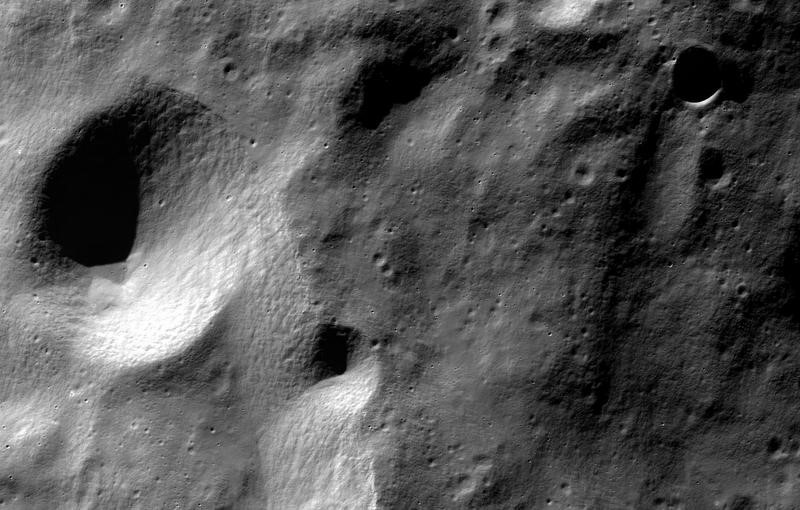Description

Source: Hindu
Disclaimer: Copyright infringement not intended.
Context
A recent study conducted by Indian space scientists, in collaboration with various research institutions, has revealed compelling evidence regarding the enhanced possibility of water ice occurrence in the polar craters of the Moon.
Details
Key findings
- The study was conducted by scientists from ISRO's Space Applications Centre (SAC), in collaboration with researchers from IIT Kanpur, the University of Southern California, Jet Propulsion Laboratory, and IIT (ISM) Dhanbad.
- The research indicates that the amount of subsurface ice within the first couple of meters beneath the lunar surface is estimated to be about five to eight times greater than the amount present on the surface. This suggests a significant reservoir of water ice within the polar craters.
- The study highlights a regional disparity in water ice distribution, with the northern polar region exhibiting approximately twice the amount of water ice compared to the southern polar region.
- The study confirms the hypothesis that the primary source of sub-surface water ice in the lunar poles is outgassing during the Imbrian period's volcanic activity.
- The distribution of water ice is believed to be influenced by mare volcanism and preferential impact cratering processes, shaping the spatial distribution of water ice deposits.
Implications for Future Missions:
- Accessing this subsurface ice through drilling will be essential for extracting water resources to support long-term human presence and exploration activities on the Moon.
- The findings provide valuable insights for selecting landing and sampling sites for future missions aimed at exploring and characterizing lunar volatiles.
- The study aligns with ISRO's future exploration plans, particularly in-situ volatile exploration missions on the Moon.
- The research findings provide essential data for supporting ISRO's mission objectives and strategic planning in lunar exploration endeavors.

About Polar craters
Formation of Moon Craters:
- Impact Events: Most Moon craters are formed by the impact of meteoroids, asteroids, and comets colliding with the lunar surface.
- Size Variability: Craters on the Moon range in size from microscopic pits to vast basins hundreds of kilometers in diameter.
- High Velocity Impact: When an object strikes the Moon's surface at high velocity, it excavates material, creating a depression known as a crater.
Types of Moon Craters:
- Simple Craters: These are relatively small, bowl-shaped depressions with a central peak or a flat floor. They are typically less than 20 kilometers in diameter.
- Complex Craters: Larger impact events create complex craters with features such as terraced walls, central peaks, and sometimes, multiple rings. These can range from 20 to hundreds of kilometers in diameter.
- Impact Basins: The largest lunar craters are impact basins, such as the South Pole-Aitken Basin and the Imbrium Basin. These are enormous features often hundreds to thousands of kilometers across, with multiple rings and extensive ejecta blankets.
Geological Processes:
- Ejecta: Material ejected during an impact forms ejecta blankets surrounding craters, which can extend for hundreds of kilometers.
- Ray Systems: Some craters exhibit ray systems, radial patterns of bright material ejected during impact events. These rays can extend for thousands of kilometers across the lunar surface.
- Secondary Craters: Smaller craters formed by the impact of material ejected from larger craters are called secondary craters. They often cluster around primary craters.
Age and Preservation:
- Crater Chronology: The density of craters on the Moon's surface provides a record of its bombardment history. Older regions have more craters, indicating they have been exposed to impacts for longer periods.
- Erosion and Modification: While the Moon lacks significant geological activity like Earth, its surface is still subject to erosion from micrometeorite impacts, solar wind, and seismic activity ("Moonquakes"). Over time, this can modify the appearance of craters.
Notable Moon Craters:
- Tycho: One of the youngest and most prominent lunar craters, with a diameter of approximately 85 kilometers. It has a distinctive ray system visible from Earth.
- Copernicus: Another prominent crater, about 93 kilometers in diameter, with a central peak complex and terraced walls.
- Aristarchus: Known for its high albedo and volcanic activity, Aristarchus is a relatively young crater with a diameter of around 40 kilometers.
Polar Craters:
- Polar craters are located near the lunar poles, specifically within regions that experience permanent shadow.
- These regions are of particular interest due to the presence of permanently shadowed areas (PSAs), where temperatures remain extremely low, and volatile compounds, such as water ice, may be preserved.
- Notable Polar Craters:
- Shackleton Crater: Located near the lunar south pole, Shackleton Crater is one of the largest and deepest PSAs on the Moon. It has been a focal point of scientific interest due to its potential for harboring water ice.
- Cabeus Crater: Cabeus Crater gained attention during NASA's LCROSS mission, which intentionally impacted a spacecraft into the crater's floor to analyze the composition of materials ejected from the impact.
Must read articles:
Moon
Sources:
Hindu
|
PRACTICE QUESTION
Q. Exploring the polar craters of the Moon serves as a gateway to understanding the history of volatiles and the potential for sustained human presence beyond Earth. Examine. (250 words)
|














